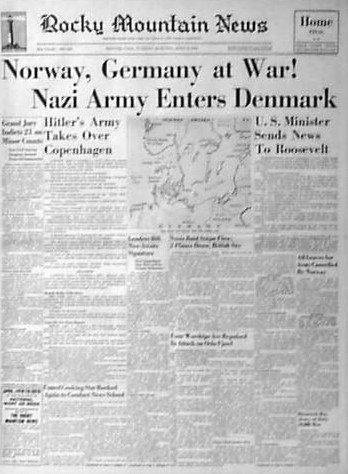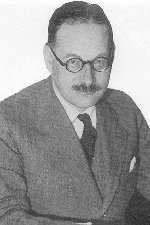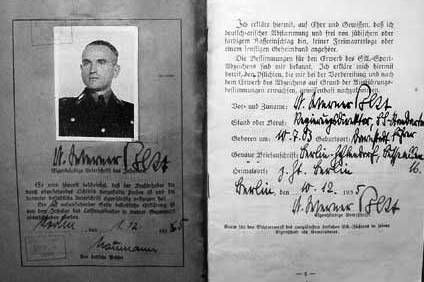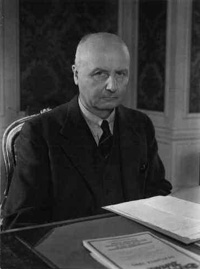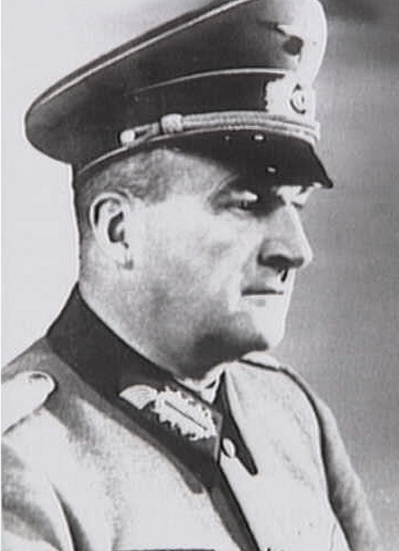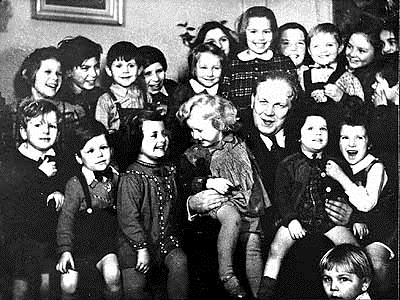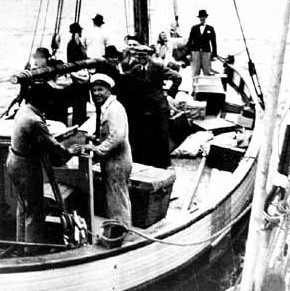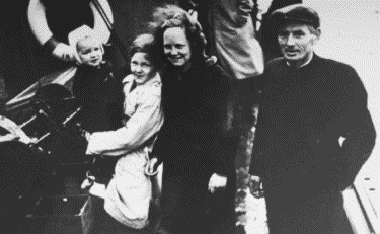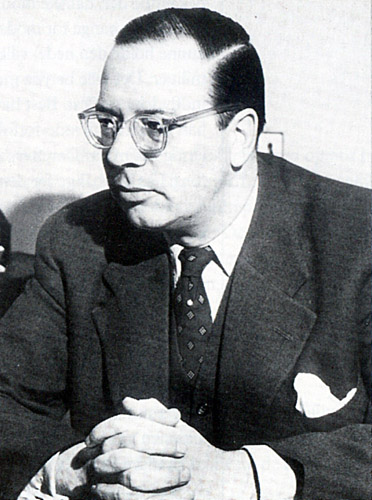The Germans invaded Denmark on 9 April 1940, in a combined
attack against Norway, a few hours later the Danish
Government accepted the German ultimatum and surrendered.
At the beginning of 1942 Himmler and Heydrich enlisted the
zealous aid of the Foreign Office to get the Nuremberg
anti-Jewish laws applied to all Western countries under
military occupation.
In Holland, a totally occupied
country this pressure could not be resisted, in France a
half-occupied country, it was half-resisted. In the case of
Denmark a nation which retained its neutrality under German
occupation, with a monarchy and constitution both
unimpaired.
Here the pressure of Ribbentrop and
Himmler was resisted with ninety-five per cent success –
almost the only bright spark in a truly dark and depressing
tale of murder and misery.
In January 1942 it was
reported in the American press that the King of Denmark had
threatened to abdicate if the German demand for Nuremberg
legislation was pressed.
As a consequence, Rademacher
the SS watch-dog over the Diplomatic Corps, advised Cecil
von Renthe- Fink, the Reich plenipotentiary in Copenhagen,
“to find occasions to point out that it would be prudent for
Denmark to prepare in good time for the Final Solution.”
But Denmark was not prudent, and in June 1942, when the
Germans were pressing for a Danish “Jewish badge” decree,
similar to which had been in force in the Reich since
September 1941, King Christian was reported to have said
that he would be the first Danish citizen to wear the badge.
Himmler now tried to proceed against the Jews in Denmark in
the guise of security measures. On 24 September 1942 he
ordered Heinrich Muller, the head of the Gestapo, to insert
the names of Jews in a list of Danish Communist and
resistance leaders whom he proposed to arrest.
No
doubt Himmler believed he could rely on the co-operation of
Renthe-Fink successor, Karl Werner Best, since Best had once
been legal advisor to the Gestapo – but Best who had left
the Gestapo to escape the clutches of Heydrich, was now
relieved of the worst anxieties of a successful careerist by
the death of his enemy.
Moreover, as a Reich
plenipotentiary in a quasi-neutral country, Best desired a
quiet life above all things, so his report to Ribbentrop on
28 January 1943, was quite daring. Best suggested that,
since the proposed measures would certainly create a
constitutional crisis in Denmark, the Danes should be asked
only to dismiss their Jews from the civil service.
Under Himmler’s prodding Ribbentrop returned to the charge,
and on 24 April, Best replied that out of 6,500 Jews in
Denmark only 31 were civil servants. Of course, there were
the 1,351 refugees from the Reich whom the Danish Government
had hitherto protected, but Best suggested that the Danes
would not be able to do this any longer if the refugees were
given back their German nationality.
Such a step was,
however, impossible under the 11th decree supplementing the
Reich Law of Citizenship, which could not be retracted in
the case of refugees in Denmark without upsetting the whole
legal fabric of the deportations from Germany.
Himmler still insisted on the full application of the Final
Solution in Denmark and Ribbentrop as usual, gave way. On 22
May he informed Best that while he could not take
instructions from Himmler, the next steps might be discussed
with Himmler in the precincts of the Foreign Office, if
necessary in Ribbentrop’s presence.
Nothing however was done till August when a disturbance in
Denmark gave Himmler the pretext he required. On 5 August
1943, Sweden renounced the 1940 agreement by which German
troops stationed in Norway were permitted to use her railway
system.
This action inspired the Danish dock workers
at Odense to refuse to repair German ships. There were riots
and arrests and on 9 August, the Danish Premier Scavenius,
threatened to resign if the Danish courts were required to
try the arrested men.
As a consequence, the Germans
introduced martial law at Odense, and on the 24 August 1943
– the day that Himmler was made Minister of Interior – the
Danish resistance movement blew up the German – occupied
Forum Hall in Copenhagen, and on the following day all the
Danish shipyards were on strike.
On the 28th the
Scavenius Government resigned, on the 29th General von
Hannecken, the German military commander, proclaimed martial
law throughout Denmark. The Danish defence forces were
interned, while the small Danish fleet either scuttled
itself or sought internment in Swedish ports.
But even now Best and von Hannecken could not take over the
government of Denmark, since they had to rely on a Committee
of Ministerial Directors to act for the absent Danish
Cabinet.
It appeared to Best, nevertheless, that this
provided the opportunity for deportations, and on 8
September 1943 he asked for police reinforcements and help
from the German Army, “so that the Jewish problem can be
handled during the present siege conditions and not later.”
But as a witness at the War Crimes trial in Nuremberg on 31
July 1946, Best tried to put the cart before the horse, he
claimed that he had only approved of martial law for Denmark
after Himmler had fixed the date for the deportations,
which, he feared would cause riots.
At the same time
he warned certain Danish politicians of Himmler’s plans, yet
according to his report to von Ribbenentrop, Best had made
it clear to the Danish Foreign Office that the arrest of
Jewish notables ”had nothing to do with the Jewish
question.”
The truth would seem to be that Best, in
company with von Hannecken and even the Security Police
chiefs in Denmark was seized at the last moment with a fear
of the world publicity which the action ordered by Himmler
would inevitably follow.
On 18 September Rolf Gunther
arrived in Copenhagen from Berlin, with a special commando
of members of Eichmann’s office. The station commander of
the Security Police in Copenhagen, Standartenfuhrer Rudolf
Mildner, at once perceived what matters would be charged to
his responsibility and flew to Berlin to get Kaltenbrunner
to withdraw the commando, but without success.
Best in the meantime, continued to cover himself either way.
Thus on the night of the round-up, he promised Ministerial
Director Svennigsen of the Danish Foreign Office to forward
the King’s petition that the Jews should be interned in
Denmark.
But Best had already tried to interest
Ribbentrop in a far less honorable proposal, proceeding from
Helmer Rostig , a former League of Nations Commissioner in
Danzig, now head of the Danish Red Cross.
This was
that the Jews should be interned in place of the Danish
soldiers, “to show that Germany was at war not with the
Danes, but with the Jews,” and that fifty to hundred Jews
should thereafter be deported for each Danish act of
sabotage.
Furthermore, on 28 September Best assured von Ribbentrop
that the deportations would start as soon as the steamer
Wartheland berthed in Copenhagen, and he complained that
through the non-co-operation of von Hannecken, the Security
Police were unable to proceed with the round-up in Jutland
and Fuenen.
Von Hannecken had in fact been engaged in an intrigue to
shift the responsibility on to Best’s shoulders. He had
asked Keitel on the 23rd to suspend the round-up during the
period in which the German Army was responsible for
maintaining order, if indeed, it was not possible to cancel
altogether such unpopular measures, which would mean “the
loss of Danish meat and fats.”
Keitel replied that Gottlob Berger, Himmler’s chief of
personnel would be in charge of the “aktion.” Von Hannecken
thereupon refused to lend the Security Police the use of his
Feldgendarmarie and Secret Field Police – a direct challenge
to Keitel and the High Command.
On 29 September Ribbentrop telegraphed Best that he had read
his complaint to Hitler in the presence of Keitel, who
denied that he had banned the use of Wehrmacht police, and
swore that he would demand an explanation from Hannecken.
But the latter told the Danish Commission in 1945 that, even
after the rocket he got from Keitel, he only provided fifty
men of a guard battalion to cordon the embarkation on board
the Wartheland.
At the Nuremberg War Crimes Trial, Colonel – General Alfred
Jodl, chief of the operations section of the High Command,
insisted that these fifty men must have been policemen. He
had telephoned von Hannecken to have nothing to do with the
deportation order, which was Himmler’s affair.
This
got back to Best via Colonel von Engelmann of the Abwehr
which was the German equivalent of MI 5. Best then
telegraphed Ribbentrop on the eve of the deportation action
“that Keitel’s order for co-operation had been revoked, and
that Keitel had misinformed the Fuhrer.”
One is to gather from al this that, except for those who
were conveniently dead like Himmler, no German carried out
the Fuhrer’s order in Denmark. In reality, the misgivings of
Germans in office played less part in saving the Jews than
the unique geographical position of Denmark, separated by a
bare ten miles of sea from the neutral Government of Sweden,
the only Government to offer unconditional asylum to an
entire Jewish population which was threatened by the Final
Solution.
But in October 1943, the Ministers of
neutral countries had less reason to be susceptible to the
German mailed fist than, for instance, the Swiss Ministry of
Justice and Police, which had refused to admit Jewish
refugees from the terror in France precisely a year earlier.
Geography and the changed way of neutrality did not however
explain everything. No rescue would have been possible if
the bulk of the Danish nation had not been sympathetic and a
very large number of ordinary people disposed to risk their
lives out of common charity.
The figures are eloquent, only 284 Jews were arrested on the
night of 1 October, of whom 50 were released and only 202
embarked in the Wartheland. They were mostly people who were
too old to hide from the police. Casual arrests in the next
few days brought the number to 477, but more than 6,000 full
Jews and 1,376 half-Jews were smuggled into Sweden in
fishing boats between 26 September and 12 October 1943.
On the morning after the round-up, Best suggested that the
interned Danish soldiers should be released at once to show
that the “Danish peasant boys” were not being treated like
Jews. Von Hannecken at the same time demanded the
abandonment of martial law.
It suited Himmler to
believe that Denmark was now “Jew –Free” and both requests
were soon granted. Best was less successful in trying to get
some of the Danish Jews out of the clutches of Eichmann’s
office. He believed that it might appease Danish public
opinion if a Jewess, aged 102, could be brought back from
Theresienstadt together with a few other very old people.
On this project von Thadden, the successor to Luther and
Rademacher , reported back to his chief Wagner, on 25
October that the RSHA thoroughly disapproved, because it
would create an impression of weakness among the Jews, if
any were brought back to Copenhagen.
In the meantime,
the Foreign Office maintained unreal negotiations with the
Swedish Government. Unofficially, the Danish Jewish refugees
were in Sweden enjoying complete liberty.
Officially they were still in hiding in Denmark and the
Swedish Government offered to intern them if the Germans
would hand them over. On 4 October the Swedish Minister in
Berlin begged that Sweden might at least be allowed to take
the children.
Weizsacker was no longer von
Ribbentrop’s First Secretary of State – since his transfer
to the Vatican, his place had been taken by Adolf
Steengracht von Moyland , who formally refused the offer,
upbraiding the Swedish Minister in Berlin in terms which he
recalled as follows:
“In very severe words I
criticized today’s Swedish morning press and told him that I
was unable to imagine what further reactions might be
possible in Sweden after the newspapers had voiced such
incredible language.
If the occasion arose, this attitude would force us to
answer in a manner not to be misunderstood. It was not
appreciated here why Sweden was unequivocally taking the
side of Bolshevism, while our blood and the blood of our
allies was being expended to keep the Communist danger from
Europe and thus also from the Nordic countries.”
It had been decided early in September that the Danish Jews
should go to Theresienstadt not Auschwitz. About 360 were
sent via the port of Swinemunde, and of these twenty died on
the journey and fifty in the camp.
Werner Best was
sentenced to death by a Copenhagen court in August 1946,
soon after his appearance as a witness at the Nuremberg War
Crimes Trial.
His appeal was not heard by the High Court till 20 July
1949, when in the light of new evidence, his sentence was
reduced to five years imprisonment. He was released on 29
August 1951.
Sources:
The Final Solution by G. Reitlinger –
Vallentine Mitchell &Co Ltd 1953 .
Beretning fra
Centralkontoret for s rlige Anliggender for Stork benhavn,
1946
PRO UK
